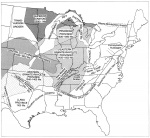New Madrid Rift Complex (Discarded)
Location
Underlies the Mississippi Valley from Arkansas and Tennessee northward to southeast Missouri, southern Illinois, and western Kentucky

References
(selected) Ervin and McGinnis 1975, Soderberg and Keller 1981, Braile et al. 1982, 1984, Sexton et al. 1986, Pratt et al. 1989, Nelson 1990
Description
A buried rift system underlies St. Croixan (Cambrian) strata in the central Mississippi Valley. Elements of the rift include the northeast-trending Reelfoot Rift (Ervin and McGinnis 1975) and the east-trending Rough Creek Graben (Soderberg and Keller 1981, see fig. 5). Two additional "arms" or branches of the rift were postulated by Braile et al. (1982). These were the northeast-trending Southern Indiana Arm and the northwest- trending St. Louis Arm. As envisioned by Braile et al. (1982, 1984) and Sexton et al. (1986), the Reelfoot, Rough Creek, Southern Indiana, and St. Louis branches formed a quadruple junction in southernmost Illinois. The name New Madrid Rift Complex was applied to the entire hypothetical four-armed rift system. It was named after New Madrid, Missouri, the scene of devastating earthquakes in 1811 and 1812.
Recent studies, including COCORP seismic profiling (Pratt et al. 1989), indicate that the southern Indiana and St. Louis Arms do not exist. The actual configuration is a dogleg comprising the Reelfoot and Rough Creek segments. In a comment to Pratt et al. (Nelson 1990), I recommended that usage of the term New Madrid Rift Complex be discontinued to avoid the implication that the dogleg rift and New Madrid Seismic Zone are coextensive.
See also REELFOOT RIFT, ROUGH CREEK GRABEN, ST. LOUIS ARM (discarded), and SOUTHERN INDIANA ARM (discarded).
